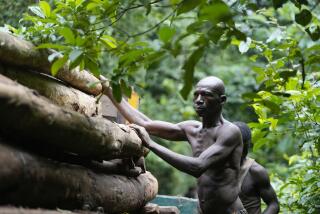Elephants killed for meat as well as ivory
- Share via
NAIROBI, KENYA — The markets in the Central African Republic offer all of the jungle’s delicacies, including monkey, chimpanzee, antelope and, if you have the cash, even elephant.
Hunters kill the elephants and cut off the ivory. Then, over grills fueled with tree branches, they smoke the meat for a day, charring the outside to preserve it for the trip to town. The main market is in Africa, where elephant meat is considered a delicacy and where growing populations have increased demand.
Most people believe demand for ivory is the biggest threat to elephants. Wildlife experts are meeting in the Netherlands through June 16 to discuss the ban on the ivory trade, but forest elephants -- perhaps the most endangered elephant species in the world -- are being hunted to extinction not only for their tusks, but for their meat.
“These elephants get poached a lot more than the eastern and southern African elephants,” said Karl Amman, a wildlife photographer and investigator into the illegal trade in animals. “I am convinced the poaching of forest elephants in the Central African region is for the meat, and ivory has become a byproduct.”
In the markets of Bangui, ivory earns a poacher about $13.60 a pound. Smoked elephant meat brings $5.45 a pound, considerably more than any other kind of meat.
A typical forest elephant, which weighs 5,000 to 6,000 pounds and produces 1,000 or so pounds of edible meat, can earn a poacher up to $180 for the ivory and as much as $6,000 for the meat. The average income in the Congo Basin is about $1 a day.
People in the forest live in such poverty that they don’t think about animal conservation, said Andrea Turkalo, a Wildlife Conservation Society researcher who works in the Dzangha-Sangha National Park. “This country can’t can run their health dispensaries; they can’t educate their children. How can you expect them to think about conservation?” she said. “I think people are still killing for ivory, but there has been a shift in the meat trade because of the human demographics. There are a lot more people here.”
Gabriel Mabele, chief of Mosapula village, said creation of the Dzangha-Sangha National Park and a ban on hunting elephants there had meant his people had less meat to eat, but they still wanted to eat elephant. “You can’t just openly put it out in the market; you have to be secretive about it,” he said. “But the hunting continues.”
Omer Kokamenko, a ranger at Dzangha-Sangha, also said elephant hunting had become more about the meat. “When someone kills an elephant whose tusks don’t weigh more than 500 grams [1 pound], it’s not for the tusks -- it’s especially for the meat,” Kokamenko said.
Forest elephants are different from their cousins that roam the savannas of eastern and southern Africa, where most are protected by rangers. Forest elephants are smaller and darker, their tusks are straighter and their ears are more oval. They range from Guinea to Uganda, but are mostly concentrated in the Congo Basin, where poverty and war are common.
Little is known about forest elephants because they live in small groups within dense rain forests. In 1989, wildlife biologists estimated the forest elephant population of the Congo Basin at 172,000.
A Wildlife Conservation Society study of six elephant areas in national parks released in April found “a combination of illegal killing and other human disturbance has had a profound impact on forest elephant abundance and distribution.”
The Convention on International Trade in Endangered Species banned trade in ivory in 1989, but some African nations won permission to sell ivory in 1999. Another sale was authorized in 2002.
Amman said the focus on the ivory trade overlooked the bigger issue of the sale of elephant meat. Amman, joined by an Associated Press journalist, documented how wildlife meat, including elephant, was being sold across the border between the Central African Republic and Congo. Government officials on both sides collect taxes on the trade, even though the business is illegal under international law. Tax collectors and more senior officials declined to answer questions about the trade or tax system.
Until governments act, the elephant population will remain in danger, Amman said.
“Better law enforcement and better governance is the underlying issue of most of the problems in Central Africa,” Amman said.
Desire Loa, a former park ranger who turned poacher, said the trade was so profitable that government officials were behind most poaching, hiring Pygmies and providing them with rifles to kill elephants.
“It’s important officials who pay for this now ... because they’re the ones who have money,” he said. “You might find me guilty today. They’ll put the handcuffs on me and take me [to jail] in town.
But Loa said he would not be there for long. “The prosecutor will tell me, tonight you’ll spend the night here,” he said. But later he’ll “give me back my weapons and tell me to go back to work ... people are against conservation.”
Associated Press writer Anthony Mitchell contributed to this report from Bangui, Central African Republic, before his death in a jetliner crash.
More to Read
Sign up for Essential California
The most important California stories and recommendations in your inbox every morning.
You may occasionally receive promotional content from the Los Angeles Times.













